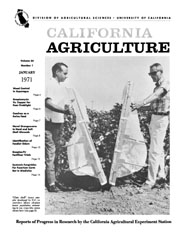


University of California
California Agriculture
|
|||
|
|||

Cover:
“Clam shell" insect sampler developed by U.C. researchers allows absolute
insect population estimating in row crops like cotton shown here.
January 1971
Volume 25, Number 1 News and opinionGeneral Information |
|||
|
University of California, 1301 S. 46th St., Bldg. 478 Richmond, CA
|